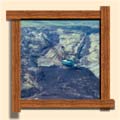 Heritage Community Foundation Presents
Heritage Community Foundation PresentsAlberta Online Encyclopedia
 |
||
  |
||
|
Home>> Issues and Challenges>> Health and Safety>> Above Ground>> Featured Article: Surface Technology |
||
| Surface Technology | ||
|
By William N.T. Wylie
The extensive underground works were complemented by a wide range of facilities above ground, serving both to support the sub-surface activities, and to prepare the coal for shipment. Constituting the main visual evidence of the mine to observers, the surface plant consisted of buildings and equipment relating to underground haulage and ventilation, the supply of power below and above ground, repair and storage, and coal preparation and transport. Besides the hoists and fans expediting the movement of materials and ventilation beneath the surface, the most crucial elements of the plant were those providing a source of power and associated with coal preparation and shipment.
William N.T. Wylie, "Coal-Mining Landscapes: Commemorating Coal Mining in Alberta and Southeastern British Columbia," a report prepared for the Historic Sites and Monuments Board of Canada, Parks Canada Agency, 2001. See Also: The Coal Industry—Overview, Rapid Expansion, Domestic and Steam Coalfields, 1914-1947: The Struggling Industry, Collapse and Rebirth, Settlement of the West, Issues and Challenges—Overview, Entrepreneurship, Technology, Underground Techniques, Surface Technology, Surface Mining, Social Impacts, Unions, 1882-1913: Unionization and Early Gains, 1914-1920: Revolutionary Movement, 1921-1950s: Labour Unrest and Setbacks, Mining Companies, People of the Coal Mines, The Middle Class, Miners and Local Government, Politics and Economics , Environmental Impacts, Health and Safety—Overview, The State and Labour Relations, The State and Development after 1918. |
||
 |
||
For more on coal mining in Western Canada, visit Peel’s Prairie Provinces.


